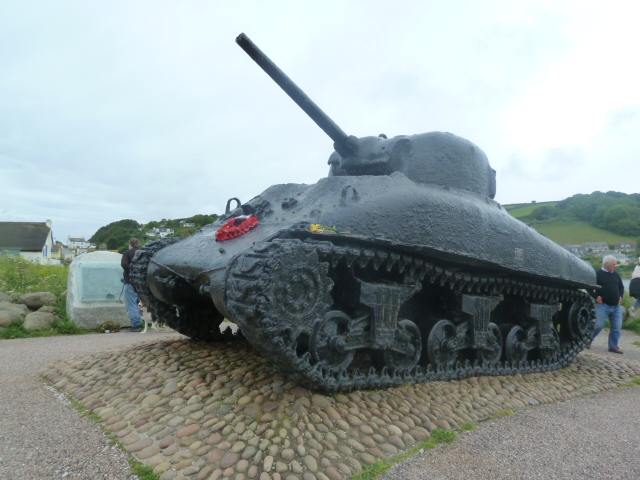This is the view of Blackpool Sands, a pretty setting with a beach that is nestled between Strete and Stoke Fleming, on the South Devon Coast. Many people flock here during the summer season. However, don’t be fooled by the word ‘Sands’ as the beach actually consists of fine shingle, rather than golden sand! Nevertheless, it’s peaceful and a wonderful place to relax. There’s a fee paying car park nearby.
Here’s a quick rundown of the facilities:
Blackpool Sands wasn’t our destination, yesterday. But as we pass by, I always take a photo! We travel this way quite frequently, into the area known as The South Hams, which is less stressful than travelling east, towards Exeter and beyond…especially on a Bank Holiday Weekend!
We continued towards Slapton.
As you can see, Slapton Ley lake, on the rhs is separated from the sea by a narrow shingle bar and a road and this lake is the largest natural lake in South West England. It’s entirely freshwater. And it’s also surrounded by reed beds and marshes etc.
This area is a Site of Special Scientific Interest ( SSI) and it was declared a National Nature Reserve (NNR) in 1993. The beauty here is outstanding and guess what…it’s all to enjoy for free…I always say that the best things are just that! There’s plenty of parking nearby.
The NNR is managed by The Field Studies Council, in partnership with Wild Planet Trust, Natural England and South Hams District Council.
And then there is the famous Sherman tank, which leads me on to the history of this lovely area.
This tank commemorates one of the biggest losses of life during WW2, when 946 men lost their lives during Exercise Tiger.
Tens of thousands of American troops were billeted around this area so that they could train for the sea borne landings in France. The Americans were to assault a beach in France. Code named ‘Utah’ and Slapton Sands was said to be the perfect replica for practising mock attacks.
However, this meant that because live ammunition was to be used, 3000 people living in the area, were evacuated from their homes, including farms, and in 1943, in moved the American army.
Over 30,000 troops were ready for their mission and in the early hours of April 28th 1944, this massive armada gathered together to get into position out at sea, when a flotilla of German E boats, in Lyme Bay, that had avoided detection, got in amongst the allies and cause chaos.
With the sea bombardment just beginning, many U.S. servicemen didn’t understand what was happening and in the resulting carnage almost 1000 men perished.
There are varying stories as to what happened, who was at fault etc etc but the whole thing was hushed up for many years…or some say it was ‘conveniently forgotten’!
However, that’s not the end of the story!
In 1969, a man called Ken Small, who had moved to the area, was beachcombing and he came across all sorts of items, such as bullet cases and tunic buttons etc He asked the local residents why such items were on the beach and they told him about the evacuation and Exercise Tiger.
And then a fisherman friend of Ken’s, told him of an object that was sitting on the sea bed, around 60 feet below the surface and three quarters of a mile off shore. Ken persuaded his friend and some divers to dive down and investigate. What they found was a Sherman tank and this discovery then encouraged Ken to find out more. He became determined to recover this tank and make a lasting memorial to all of those who perished.
This didn’t happen overnight! It took ten more years for Ken to overcome bureaucracy, and achieve his dream to raise the tank and stand it near to the village of Torcross.
After years of silence, the media attention led to contact with survivors, family members etc and they began to tell their stories. Later on, in 1988, Ken wrote a book, ‘The Forgotten Dead’
Every year, the Royal Tank Regiment organises a memorial service, held by the Torcross tank, on the nearest Sunday to April 28th ( the Exercise Tiger anniversary) You can read much more about this fascinating piece of history, here .
Finally, this little cafe is where we always stop for coffee and / or a light lunch. It’s fabulous! The range of food is superb and the service is always very friendly. It’s called, ‘The Billy Can.



















What a fantastic story, thanks for sharing it. xx
ReplyDeleteYou have brought back some memories for me. I remember a family holiday in Stoke Fleming and visiting Blackpool Sands, Bee Sands and Slapton Sands along the coast whilst we were there, so long ago now. The story of Slapton and exercise Tiger is so sad, I'm glad it is now remembered. The cafe looks wonderful:)
ReplyDeleteWhat a very interesting post. The Billy Can looks fun.
ReplyDeleteWhat an interesting visit in a beautiful spot. 😊
ReplyDeleteI do wish I lived nearer to the coast. Interesting story about the tank - I’d never heard of that disaster.
ReplyDeleteWhen I think of Blackpool I think of a very different beach!
ReplyDelete